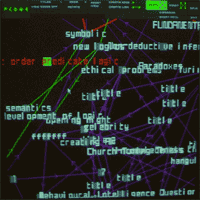
What is Float?

FLOAT is an experimental collective software space, the multi user hyperstructure kit, the program equiped with ability of gathering information and learning during the interaction. Float deals with the experimental topics as Tactical Media, Hacktivism, Artificial Intelligence. Float, as opposed to other systems, is that its database is not a static entity, which sits there passively waiting for queries to set it into motion. Instead, it is constantly refining its structure. The user must always have the possibility of adding new content, re-organizing the information. In order to organize information was used DAH -directed acyclic hipergraph.
Latest presentations
LMCC-NYC [ We presented Float in Lower Manhattan Culture Council and Harvestworks Digital Media Arts Center. ] November 17, 2005
State of Emergency Embassy [ We made new radical actions in NYC (SEE is a online and physical infrastructure which deals with spying on data and codes in the www space). ] January 18, 2006
WWAI [ We lead a panel concernig artificial intelligence and future of WWW during Siggraph 2005 in Los Angeles. World Wide Articial Intelligence: How the Web is growing? Into social superorganism or a mass disconected Information? ] August 2-4, 2005
HACKART & SEE [ We had the presentation and talk in Entropia Gallery. We put new texts online (Hacktivism and tactical media: a new strategies in the contempopary art, "We treat our software as a weapon, as a conceptual vehicle to explore issues of domination and compulsion in the physical and digital space." Robert B. Lisek] March 10-23, 2006
Interface
The Float interface is divided into two parts: tool (tool interface) and bot (visual bot). tool provides several commands to browse, to create and to select nodes, whilst bot displays the user activity in real-time. The visualization is based on the users actions, statistical information about the data as well as bayesian logic rules. That is the reason why the complexity of its visual output is according to the increasing number of users! You can use bot and tool individually, but through an alternating perception you will merge visual and textual cognition processes in order to empower abductive reasoning in digital contexts.
Architecture
The data structure is as simple as you can get : a vector of Nodes, a vector of Edges. The owner of these vectors defines an interface for the rest of the application to access the graph, and there are some very nice algorithms here. In particular, there is a path searching algorithm, to detect potential cycles, as well as conversion from DAG->Hasse, and DAH->LinearExtensions. DAG->LE can be extended to any number of extensions, limited only by the graph, depending how the edges are searched.
Background
Float was commissioned by Harvestworks Digital Media Arts Center, a research project based at the HDMAC artists residency program. Harvestworks is a nonprofit Digital Media Arts Center that provides resources for artists to learn digital tools and exhibit experimental work created with digital technologies. Our programs are made possible with funds from New York State Council on the Arts, the National Endowment for the Arts, the NYC Dept. of Cultural Affairs etc.
Goals
The aim of the FLOAT project was to investigate and
create the platform that
- supports the exploration of the experimental topics as:
- CyberArt, Tactical Media, Hacktivism , Artificial Intelligence,
- supports knowledge transfer and the exchange of know-how abilities
- provides right access to the flexible, intelligent network
- builds alternative methods for the collection and distribution data
- transforms closed circle of power systems into the open network
- checks the artist's position in relation with the stock market.
Time
Float research and development started in March 2005.